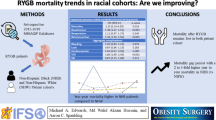Abstract
Background
Ethnic disparities in patterns of utilization and outcomes after Roux-en-Y gastric bypass surgery (RYGB) were examined from Bariatric Outcomes Longitudinal Database.
Methods
Descriptive statistics were used for demographics of Whites, Blacks, or Hispanics undergoing RYGB with 1 year of follow-up, between June 2007 and October 2011. Multivariate logistic and normal regression models, controlling for baseline characteristics, examined relationships between race and outcomes. T tests were used for continuous variables and Pearson chi-square test for categorical variables.
Results
Study patients (108,333) were79 % White, 12 % Black, and 9 % Hispanic. Fewer Black males underwent surgery (15 %) compared to Whites or Hispanics (∼22 %). Blacks compared to Whites were younger (42.7 ± 10.6 vs. 46.4 ± 11.6 years), heavier BMI (50 ± 9.1 vs. 47.4 ± 8.0 kg/m2), and more often hypertensive (57 vs. 52 %). Other comorbidities were higher in Whites. Thirty-day mortality rate was equivalent (0.23–0.26 %), but serious adverse events were higher for Blacks (3.65 %) versus Whites (3.19 %) and Hispanics (2.01 %). At 1 year, weight and comorbidity burden declined significantly but less in Blacks despite adjustment for baseline characteristics.
Conclusions
Fewer Black males underwent RYGB. Despite a smaller percent decline in BMI and comorbidities in Blacks, all races benefitted significantly from RYGB. Influence of other factors such as diet, culture, and genetics needs to be investigated further.


Similar content being viewed by others
References
Flegal, K.M., et al., Prevalence of obesity and trends in the distribution of body mass index among US adults, 1999–2010. JAMA, 2012. 307(5): p. 491–7.
Yoon, S.S., et al., Hypertension among adults in the United States, 2009–2010. NCHS Data Brief, 2012. (107): p. 1–8.
Adams, T.D., et al., Long-term mortality after gastric bypass surgery. N Engl J Med, 2007. 357(8): p. 753–61.
Prachand, V.N., M. Ward, and J.C. Alverdy, Duodenal switch provides superior resolution of metabolic comorbidities independent of weight loss in the super-obese (BMI > or = 50 kg/m2) compared with gastric bypass. J Gastrointest Surg, 2010. 14(2): p. 211–20.
Prachand, V.N., R.T. Davee, and J.C. Alverdy, Duodenal switch provides superior weight loss in the super-obese (BMI > or =50 kg/m2) compared with gastric bypass. Ann Surg, 2006. 244(4): p. 611–9.
DeMaria, E.J., et al., Baseline data from American Society for Metabolic and Bariatric Surgery-designated Bariatric Surgery Centers of Excellence using the Bariatric Outcomes Longitudinal Database. Surg Obes Relat Dis, 2010. 6(4): p. 347–55.
Hutter, M.M., et al., First report from the American College of Surgeons Bariatric Surgery Center Network: laparoscopic sleeve gastrectomy has morbidity and effectiveness positioned between the band and the bypass. Ann Surg, 2011. 254(3): p. 410–20; discussion 420–2.
Birkmeyer, N.J. and N. Gu, Race, socioeconomic status, and the use of bariatric surgery in Michigan. Obes Surg, 2012. 22(2): p. 259–65.
Madan, A.K., et al., Are African-Americans as successful as Caucasians after laparoscopic gastric bypass? Obes Surg, 2007. 17(4): p. 460–4.
Parikh, M., et al., Comparison of outcomes after laparoscopic adjustable gastric banding in African-Americans and Whites. Surg Obes Relat Dis, 2006. 2(6): p. 607–10; discussion 610–2.
Farley, T.A., et al., Deaths preventable in the U.S. by improvements in use of clinical preventive services. Am J Prev Med, 2010. 38(6): p. 600–9.
Belle, S.H., et al., Relationship of body mass index with demographic and clinical characteristics in the Longitudinal Assessment of Bariatric Surgery (LABS). Surg Obes Relat Dis, 2008. 4(4): p. 474–80.
National Diabetes Fact Sheet: national esti-mates and general information on diabetes and prediabetes in the United States, 2011., 2011., G.U.S.D.o.H.a.H.S. Atlanta, Centers for Disease Control and Prevention, Editor. 2011.
National Diabetes Information Clearinghouse. 2011 July, 2011 [cited 2013 May 10]; Available from: http://diabetes.niddk.nih.gov/statistics/index.aspx.
Martin, M., et al., Socioeconomic disparities in eligibility and access to bariatric surgery: a national population-based analysis. Surg Obes Relat Dis, 2010. 6(1): p. 8–15.
Lynch, C.S., et al., Obese African-American women's perspectives on weight loss and bariatric surgery. J Gen Intern Med, 2007. 22(7): p. 908–14.
Santry, H.P., et al., Predictors of patient selection in bariatric surgery. Ann Surg, 2007. 245(1): p. 59–67.
Madan, A.K., et al., Comparison of IL-8, IL-6 and PGE(2) formation by visceral (omental) adipose tissue of obese Caucasian compared to African-American women. Obes Surg, 2006. 16(10): p. 1342–50.
Benotti, P., et al., Risk Factors Associated With Mortality After Roux-en-Y Gastric Bypass Surgery. Ann Surg, 2013.
Maciejewski, M.L., et al., Risk stratification of serious adverse events after gastric bypass in the Bariatric Outcomes Longitudinal Database. Surg Obes Relat Dis, 2012. 8(6): p. 671–7.
Tiwari, M.M., et al., Differences in outcomes of laparoscopic gastric bypass. Surg Obes Relat Dis, 2011. 7(3): p. 277–82.
Author information
Authors and Affiliations
Corresponding author
Additional information
Presented as an oral presentation at the Society for Surgery of the Alimentary Tract Annual Meeting, Orlando 2013 and was selected as Best of DDW presentation.
Rights and permissions
About this article
Cite this article
Sudan, R., Winegar, D., Thomas, S. et al. Influence of Ethnicity on the Efficacy and Utilization of Bariatric Surgery in the USA. J Gastrointest Surg 18, 130–136 (2014). https://doi.org/10.1007/s11605-013-2368-1
Received:
Accepted:
Published:
Issue Date:
DOI: https://doi.org/10.1007/s11605-013-2368-1



